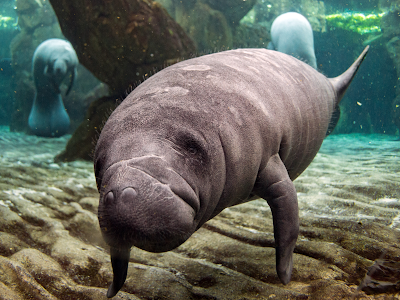The findings were published in Palaeontologia Electronica by lead author Christopher Bell, a professor at the UT Jackson School of Geosciences with co-authors Sam Houston State University Natural History Collections curator William Godwin and SHSU alumna Kelsey Jenkins — now a graduate student at Yale University — and SHSU Professor Patrick Lewis.
The eight fossils described in the paper include manatee jawbones and rib fragments from the Pleistocene, the geological epoch of the last ice age. Most of the bones were collected from McFaddin Beach near Port Arthur and Caplen Beach near Galveston during the past 50 years by amateur fossil collectors who donated their finds to the SHSU collections.
The Jackson Museum of Earth History at UT holds two of the specimens. A lower jawbone fossil, which was donated to the SHSU collections by amateur collector Joe Liggio, jumpstarted the research.
Manatee jawbones have a distinct S-shaped curve that immediately caught Godwin's eye. But Godwin said he was met with scepticism when he sought other manatee fossils for comparison. He recalls reaching out to a fossil seller who told him point-blank "there are no Pleistocene manatees in Texas."
But an examination of the fossils by Bell and Lewis proved otherwise. The bones belonged to the same species of manatee that visits the Texas coast today, Trichechus manatus. An upper jawbone donated by U.S. Rep. Brian Babin was found to belong to an extinct form of the manatee, Trichechus manatus bakerorum.
The age of the manatee fossils is based on their association with better-known ice age fossils and paleo-Indian artefacts that have been found on the same beaches.
It's assumed that the cooler ice age climate would have made Texas waters even less hospitable to manatees than they are today. But the fact that manatees were in Texas — whether as visitors or residents — raises questions about the ancient environment and ancient manatees. The Texas coast stretched much farther into the Gulf of Mexico and hosted wider river outlets during the ice age than it does today. Either the coastal climate was warmer than is generally thought, or ice age manatees were more resilient to cooler temperatures than manatees of today.
Subsurface imaging of the now flooded modern continental shelf reveals both a greater number of coastal embayments and the presence of significantly wider channels during ice age times.
If there was a population of ice age manatees in Texas, it's plausible that they would have ridden out winters in these warmer river outlets similar to how they do today in Florida and Mexico.
Reference: Christopher Bell, William Godwin, Kelsey Jenkins, Patrick Lewis. First fossil manatees in Texas: Trichechus manatus bakerorum in the Pleistocene fauna from beach deposits along the Texas Coast of the Gulf of Mexico. Palaeontologia Electronica, 2020; DOI: 10.26879/1006

